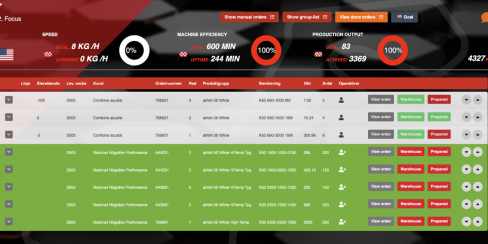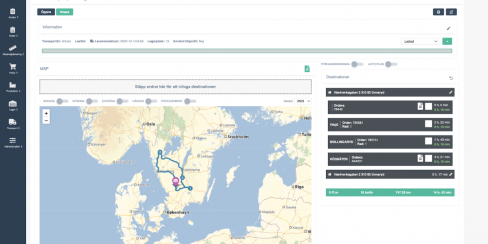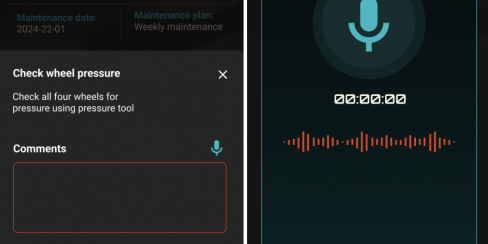AI-enhanced system for optimizing manufacturing workflows and logistics

Introduction
Invens is an innovation-focused Swedish tech firm that primarily serves manufacturing companies and small-to-medium-sized enterprises. LiteBreeze worked with Invens on their platform IPS (Invens Production System), an application designed to streamline and manage manufacturing workflows, production processes, and order management. It also supports transportation coordination for factories that have adopted digital technologies.
Customer base
IPS is generally used by clients with fairly complex production and delivery workflows – where swift and accurate responsiveness is required. Their clients include leading Swedish manufacturers, logistics firms, and industrial equipment suppliers.
Core features
IPS is equipped with the following core features:
Live truck tracking: Customers get real-time notifications of truck movements, enabling them to predict delivery times accurately.
Real-time machine monitoring: If a machine stops working, IPS instantly alerts the relevant personnel. After repairs, the platform records the cause, enabling predictive maintenance and minimizing downtime.
AI integration
Retrieval-Augmented Generation (RAG)
Admins can upload documents such as user manuals and company principles. When a user asks a question, the system retrieves relevant information from the documents to provide an answer.
Work Flow: Admins upload documents (PDFs) like manuals or guidelines. When a user asks a question, the system searches the uploaded documents and generates a clear, and natural-sounding answer based on the most relevant content.
Background technology: Vue, Laravel, Python, and Pinecone vector database.
Technical workflow:
1. Document processing: When a user uploads a document via the Laravel API, it triggers a Python script that converts the PDF to vector embeddings, which are stored in Pinecone. A reference to the document’s vector data is then saved in the database.
2. Answering questions: When a user asks a question, Laravel sends it to the Python API, which connects to the Pinecone database and generates an embedding using OpenAI, searches Pinecone for relevant document vectors, and sends the results to GPT via a paid OpenAI API to produce an accurate answer. The response is then returned to Laravel.
Demo: Smart-features: Retrieval-Augmented Generation (RAG)
GitHub Copilot
Litebreeze developers utilised GitHub Copilot for faster coding, debugging support, resulting in significantly reduced task times.
Smart voice reporting with multilingual translation
This feature was mainly aimed for users working in factories. In certain cases, they may need to type long descriptions about machine failures or maintenance-related issues. With this feature, they can simply click on the mic icon next to the input fields and start speaking. Once they’re done, they can enhance the text by:
1. Checking the grammar.
2. Translation into Swedish if the employee speaks another language. For instance, Albanian-speaking staff can transcribe and translate speech into Swedish for team collaboration.
3. Technologies Used: Recordrtc, OpenAI speech to text model
Demo: Voice to Text
AI-powered answers from database
This feature allows the AI chatbot to fetch relevant information from the database and provide accurate answers to users. When a user provides details about a machine and its issue, the chatbot looks up matching troubleshooting guides:
1. If only one guide is found, it tells the user the full guide directly.
2. If there are multiple matches, it informs the user about the options and asks them to choose the most relevant one.
3. If a specific guide is already known, the chatbot shares it right away.
4. If no guide is found, it politely lets the user know.
All responses are strictly based on the actual content in the database, with no extra information added by the AI. This feature has been hidden for the time-being according to the client’s instructions.
Technical Workflow
The developers used the OpenAI RealtimeClient to communicate with users and collect all the required parameters. To facilitate this, we added a tool on the frontend. Once the RealtimeClient gathers all the necessary parameters, it calls the backend API to retrieve the corresponding data. The real-time API then processes the data and responds to the user. In the attached screenshot, it can be seen that the parameters are listed clearly. When the user interacts, the tool extracts the relevant parameters and triggers the backend API call accordingly.
Technologies used
Frameworks and languages
Laravel+Vue(2 & 3) , Python
APIs
Mercedes, Volvo, and Scania APIs – for live tracking trucks. ERP integrations like Monitor G5, Microsoft Office 365, Fortnox, Garp, and Visma
Libraries
1. Leaflet.js – for drawing the navigation of trucks in transport planning
2. AmChart – for analytics
3. WebSocket – for chat
4. Recordrtc
Third-Party Solutions / Tools
1. OpenAI – for voice assistant and text conversion
2. Progressive Web Application – for use in iOS and Android devices
3. Capacitor – to convert the PWA to iOS app and publish it to the App Store
4. Firebase – for in-app push notifications
5. GitHub Copilot – for coding
6. Pinecone – vector database
Future priorities
Smart Maintenance Planning with AI: A project under the “Maintenance System” application involves an AI feature capable of generating database entries via conversational AI. Example: A request like “Can you plan a new maintenance for the carding machine?” prompts the system to ask for the necessary details and automatically generate the schedule.
Fine-Tuning AI with IPS Production Data: With many production orders processed weekly, there are plans to fine-tune the ChatGPT model using internal IPS data. This would enable a custom AI chatbot capable of:
1. Real-time order tracking
2. Accessing production line data
3. Supporting automated production planning
4. Estimating completion dates
5. Calculating purchase quantities
Benefits for clients with similar needs
Organizations can benefit from AI-enhanced platforms like IPS by automating repetitive tasks, reducing human error, and enhancing operational efficiency. Leveraging scalable, user-friendly, and data-driven technologies, non-technical users can achieve digital transformation, reduce costs, and maintain a competitive edge in their particular industry.



